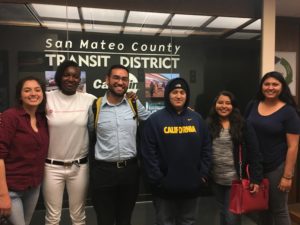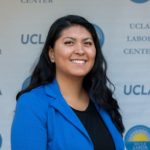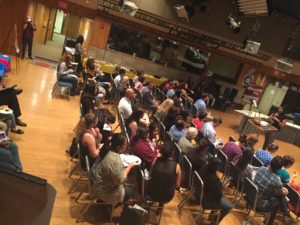It’s taken me a little bit to bask in the passing of Measure W in San Mateo County. Bear with me with my long reflection! This is a half-cent sales tax that will fund county-only transportation projects. It will generate $80M per year or $2.4B over the course of 30 years. This is where I poured a very significant amount of energy while working in San Mateo County.

At YLI, we started working with youth leaders in January 2016 (thanks to Get Healthy San Mateo County), did hardcore community participatory research with the brilliant support of Urban Habitat (Shout out to Bob!), and ran a comparative study between what transportation access looked like in an urban versus rural environment. We got in front of SamTrans to present our findings and recommendations and helped to craft the Youth Mobility Plan, which aims to increase youth ridership and affordability for youth throughout the years.
The results of our research were simple: youth, seniors, and other transit-dependent folks need more affordable, reliable, and accessible public transit. We cannot forget about them. Our low-income families, students, and seniors deserve the opportunity to move in the heart of Silicon Valley.
We needed people power. Throughout the year, previous YLI Program Coordinator Zaki Hussein and I met with over 40 different partners including CBOs and local decision makers, and worked with 30+ amazing youth, to get people sparked on what transportation equity looked like. We were scheduled to have a big event on Wednesday, November 9th, 2016. Y’all remember that day? TRUMP GOT ELECTED PRESIDENT. It was a pretty heavy day, but yo, partners showed up. We had a room full of people who cared about everything DJT didn’t. It was powerful and fueled the work that was about to happen in the next two years.
So then we thought, where do we take this work? Youth are telling us transportation is needed everywhere, local decision-makers are telling us they got their hands tied because it’s a regional issue. In 2017, gridlock was real on highways 101, 92, and 280, and the housing crisis was intimately tied to our work. Two of our own youth were displaced to Alameda County in the middle of their school year because they could not afford to live in San Mateo County. It was too much to ask for a youth to commute back and forth. But the youth did it anyway until the end of the school year.
So at this point, it was clear we needed a collective effort. Our Senior Program Director, Fahad Qurashi spearheaded the brilliant opportunity to build a countywide, multi-generational transportation coalition in San Mateo County (thanks Silicon Valley Community Foundation). Fahad pointed at me to lead it. I was like, “Fahad, um that’s a lot, something that’s never been done, and I’m the lucky one to make that happen?” His answer: “I believe in you, you got this.”
On Valentine’s Day 2017, we had our first Transportation Equity Allied Movement Coalition (TEAMC) meeting. The room was full of transit policy experts, community residents, direct service workers, labor reps, school district reps, and many other sectors. In the first six months, we came up with transportation principles to guide our work, which was signed by almost 30 orgs. These principles became the blueprint for Measure W’s principles!

TEAMC merged our power with our friends from Transform, Menlo Spark, Silicon Valley Bicycle Coalition, Friends of Caltrain, and Sustainable San Mateo County, among others. We had power mapping meetings, monthly coalition meetings, trainings. We realized that this was the first time that an organized effort on behalf of the people who cared about transportation was bubbling.
The bigger question for me was, is this REALLY happening? 2017 was big for our youth leaders, too. They ran a concurrent countywide research effort to make sure youth voice was included in the plan. It was such valuable work. They highlighted and made it clear through evidence-based research that if more public transit options were available traffic congestion would decrease, the environment would benefit, and communities would overall be healthier. That definitely set the tone for 2018.
In 2018, TEAMC decided to take on this opportunity to work in partnership with SamTrans to create a ballot measure that would be on the 2018 November ballot to generate revenues for transportation projects. And SamTrans hired a dedicated staff member, which is pretty awesome — you don’t see this a lot in other transit districts, or systems. The role of this staff person was to implement one of the plan’s many projects, the Youth Ambassador Program. This was only an idea in 2016!
What I am about to share is what I LOVED ABOUT TEAMC. First, we wrestled with the fact that it was a regressive sales tax. Low-income families hurt the most when regressive taxes are implemented. Why would we go for that?

However, IF this tax didn’t pass, low-income people also have the most to lose. People who rely on the bus to get to school, work, grocery stores, and home hurt the most. 75% of SamTrans ridership are people of color and the average yearly income of riders is $40k. The median income in San Mateo County is what? $120k/year now? Low-income folks are already paying the price of decades of disinvestment in public transit and highway expansions that never benefited them. We knew we couldn’t correct that with just a ballot measure, or the potential of $2.4B over 30 years. But we were going to try.
February to May 2018 were specially hard months. TEAMC collected 1000+ community resident surveys, did 5 Spanish/English community forums that brought together over 200 residents, and did so much more to make sure our monolingual speakers and families got a chance to weigh in during the budget period of the process. Our survey results were clear, people wanted more public transportation options. We were regulars at all decision maker meetings as well, and it was truly a beautiful thing to show up as a coalition to decision-making meetings. We definitely put the TEAM in TEAMC.
The latter half of 2018 was campaign mode. I moved to SoCal July 2018. Eduardo Gonzalez and Fahad Qurashi, thank you for holding down TEAMC during this time, for activating our UNLIKELY voters, and making sure everyone and anyone voted for Measure W. When we talk about the “slim margin” I would like to give that credit to folks on the ground who were hustling to make sure that civic engagement was high during these elections.
AND IT WORKED.
This was my first time working on a countywide project like this, with so much potential, and so much to lose as well. There are so many steps y’all! Chris Lepe, Adina Levin, Bob, Emma, Diane, and many more partners. YOU ALL HOLD IT DOWN. I’m so honored to have shared space in so many prep meetings at Starbucks and that pizza place across from Samtrans to make sure diverse voices were taken into account in the assessment period, in coming up with our values, planning the expenditure plan around the needs of communities, and, above all, in encouraging significant community engagement and public participation in the process.
SamTrans did a good job through all their community meetings and survey outreach. Shout out to them, too! But, TEAMC decided to do more. Y’all, I went home so late so many weeks and woke up so early everyday because the hours in the day were not enough to ensure that community residents, experts in their communities, knew about the decisions that were about to change the course of their lives.
Like I said, our communities have so much to lose, but now they have so much to gain. Sure 35% of the spending plan IS going to highways, but 65% is going to public/active transportation. You bet we fought hard for this. This plan prioritizes people over cars. It changed the way we think about transportation in San Mateo County. It shows commitment from decision-makers to transform the future of transportation. It means that for the next 30 years, our 14-18 year olds will have a chance to see this transformation. This after all, was started by them, and is for them.
AND most importantly, the work is not done! It never is. Transportation equity does not have an expiration date. Good luck! I miss you all, but I know that this is the kind of work that is so evergreen that it will go on without me. I love that.
Like my good friend Bob Allen once said, “Transportation is like oxygen. You don’t notice it until it’s gone.” I learned so much about what it looks like to lead a policy with values and principles, to put the needs of under and misrepresented communities first, to move the needle on equity in ways we did not imagine in 2016, and most importantly, I learned what TEAMwork looks like. All the good, long days, honestly, learning on the SPOT but carrying the stories of the youth I worked with everyday made it possible for a youth-serving organization to get into the transportation equity conversation. Who would have thought?
Got a lot of love for all the community partners, coalition members, San Mateo County staff, and youth leaders. You all literally make San Mateo County move for you. <3
